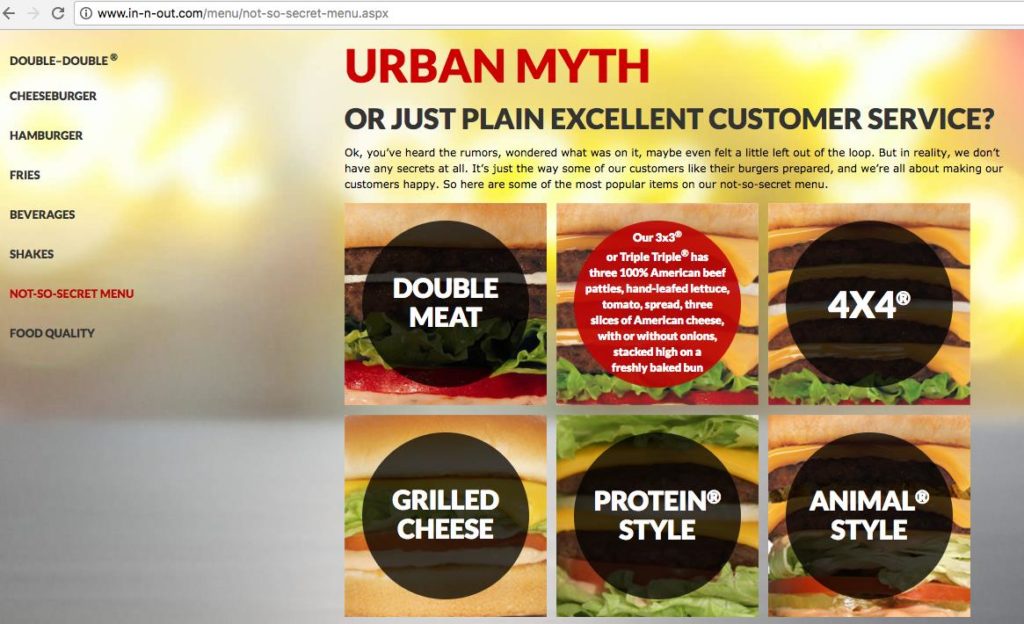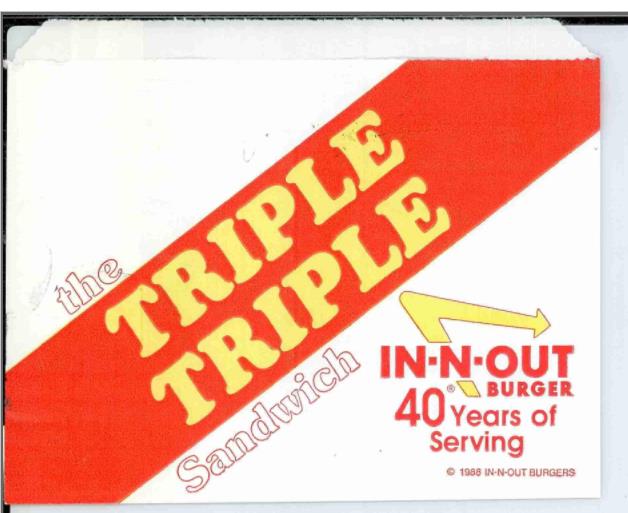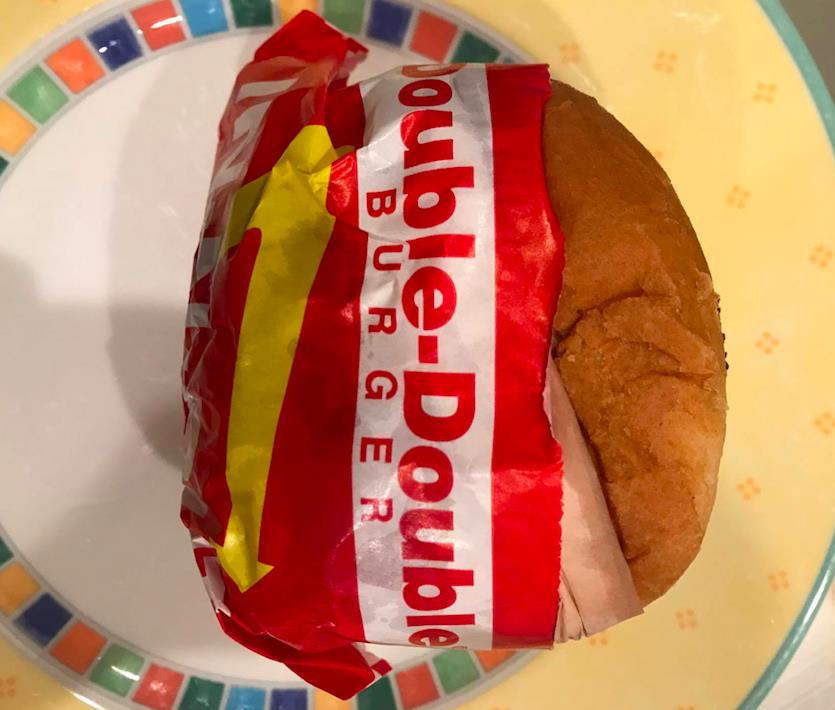Doubling (& Tripling) Down on Trademark Protection For Secret Menu Items–In-N-Out v. Smashburger (Guest Blog Post)
by guest blogger Alexandra Jane Roberts
Last week, California-based burger chain In-N-Out sued Denver-based Smashburger, alleging infringement and dilution of trademarks including DOUBLE-DOUBLE and TRIPLE TRIPLE (for, among other things, “hamburger sandwiches and cheeseburger sandwiches”). Smashburger recently applied to register TRIPLE DOUBLE and SMASHBURGER TRIPLE DOUBLE for sandwiches and restaurant services. The federal lawsuit follows on the heels of In-N-Out’s opposition to Smashburger’s applications, currently pending before the TTAB. In addition to asserting its registered marks against Smashburger, In-N-Out claims Smashburger infringes its common law trademarks as well. Its complaint does not precisely articulate which common law trademarks it has in mind, but does include the following in its statement of facts: “In-N-Out is…widely known for providing variations of its menu items to customize orders for providing an exceptional customer experience. Accordingly, In-N-Out’s customers commonly mix the DOUBLE-DOUBLE, TRIPLE TRIPLE, and QUAD QUAD menu names to form names to customize orders, including ‘Triple Double.’” (¶ 21).
A DOUBLE-DOUBLE at In-N-Out is just what you’d expect: two beef patties and two slices of cheese, with assorted condiments. A TRIPLE TRIPLE is three and three, and a QUAD QUAD (also an In-N-Out registered trademark) is four and four. The company also uses 2×2, 3×3, and 4×4, respectively. A TRIPLE DOUBLE at Smashburger comprises two patties and three slices of cheese.
Right about now you may be wondering whether all those terms aren’t merely descriptive or even generic for the burgers at issue, and thus unprotectable. A descriptive mark describes some attribute or characteristic of the goods or services with which it’s used, and “double double” and “triple triple” describe the number of patties and cheese slices in the burgers. But descriptive marks are protectable with a showing of secondary meaning, and DOUBLE-DOUBLE and TRIPLE TRIPLE have been used by In-N-Out since the 1960s and registered since the 1970s and 1980s respectively, giving them decades to acquire distinctiveness. What’s more, the marks are incontestable under Section 15, so they will be presumed valid and cannot be challenged based on mere descriptiveness (remember Park ‘N Fly?).
Smashburger could still invalidate the marks by proving they are or have become generic. But adjectives are typically found to be at least thinly descriptive, since they don’t name the genus to which the goods or services belong, and the doubling of each term (“triple triple” rather than “triple burger”) might lead factfinders to conclude the marks are capable of serving as source indicators. The USPTO treated Smashburger’s allegedly infringing marks, including TRIPLE DOUBLE, as inherently distinctive for burgers. Of course, the TTAB recently affirmed the USPTO’s refusal to register “footlong” for sub sandwiches; In-N-Out could be subject to the same fate as Subway if evidence suggests consumers understand “double double” and “triple triple” as generic phrases for double or triple burgers available from a variety of sources rather than just one.
And while an incontestable mark can’t be invalidated based on mere descriptiveness, it can still be challenged based on abandonment or nonuse. DOUBLE-DOUBLE is presumably safe, given its prominent placement on the menu board of every In-N-Out location. While names of menu items don’t make for particularly strong marks, plenty of precedent exists for granting them protection.
But TRIPLE TRIPLE is neither listed on the restaurant’s menu boards nor displayed on other signage. Nor does it appear as the name of an item on the restaurant’s “Not-So-Secret” menu, featured on its website and app and discussed on various blogs. It’s referenced only once on the Not-So-Secret menu in the text describing the item billed as “3×3”—text that’s only visible when site visitors hover over the item name (“Our 3×3® or Triple Triple® has three 100% American beef patties, hand-leafed lettuce, tomato, spread, three slices of American cheese, with or without onions, stacked high on a freshly baked bun”).
The In-N-Out app is similar to the restaurant’s website but doesn’t appear to use TRIPLE TRIPLE at all, even in the description of the 3×3. While the company’s complaint generally alleges use of the relevant marks “on its menu, food packaging, advertising materials and promotional items,” I’m unable to find any examples of such use of TRIPLE TRIPLE, and an informal survey of friends who frequent the restaurant has not revealed any leads. In-N-Out’s complaint also alleges that its registered marks include menu items from its Not-So-Secret Menu that “are publicized and widely known and used by customers, whether by word of mouth or, more recently, by online communications like social media and blog posts.” The specimen on file with the USPTO from 2008 is an image of a small burger bag that features the words “TRIPLE TRIPLE.”
But the same friends tell me they’ve never seen or received such a bag, so it’s possible the bags are no longer in use. One of my students sent his sister to In-N-Out in Westwood to investigate; she came back with photographic evidence that the 3×3 is not consistently packaged in bags bearing the TRIPLE TRIPLE mark (shown here: her 3×3 in a Double-Double bag).
While the complaint seems architected to disguise or gloss over it, actual use of TRIPLE TRIPLE as a trademark for burgers appears weak. In order to warrant protection, matter must be used on or in connection with goods or services that move in interstate commerce, and it must be used in such a way that consumers will recognize it as serving a source indicating function. I’ve spent the past year researching and writing about the latter requirement, “use as a mark.” Notwithstanding the circle-R sign (®), the company’s use of TRIPLE TRIPLE on its website comes up short—the mark appears in tiny font, embedded in descriptive text, and it’s not set apart from the surrounding words or images in any way, so it likely fails to meet the statutory requirement. The 2008 use on burger bags likely does satisfy use requirements, even if consumers don’t see it until they’ve already made their purchase—TRIPLE TRIPLE is large, bright, and featured prominently on the bag. But if that use no longer persists, a court might find that the mark fails to function as a trademark or that In-N-Out has abandoned its use.
Finally, the question remains whether use of a mark by the public will suffice to support a producer’s rights in that mark. In-N-Out alleges that it “uses the Registered Marks…through customer use” (¶ 20). And courts and the USPTO have occasionally applied public use doctrine to find that the widespread use of a mark by the public, like “Coke” for Coca-Cola, “Mac” for Macintosh computers, or “the Evil Empire” for the Yankees, can give rise to protectable trademark rights or at least provide adequate foundation to prevent a competitor from making use of a confusingly similar term. In those cases, the public stands in as surrogate user, and its early, organic use inures to the benefit of the producer.
But trademark rights remain dependent on a sufficient segment of the public regarding the phrase or nickname as a source indicator. That doctrine is a stretch here if consumers are using “triple triple” and “triple double” simply to order triple burgers, as it does not necessarily indicate that the phrases serve a trademark function or that use of similar marks by someone else would cause confusion. And public use doctrine is almost always applied to consumer-generated brand nicknames, rather than names for new products that consumers themselves create. If the “triple double” is a crowd-sourced secret menu item that In-N-Out doesn’t actively promote (or even provide information about consistent with industry regulations), it’s easily distinguishable from those nickname cases. On the other hand, the public’s use may be far more extensive than what I can see with a quick search—I left California in 2005 and I haven’t eaten a hamburger since 2002, so I’m not representative of the fans who troll social media for burger rankings and secret menu tricks. The public’s use in combination with the company’s incontestable registration could obviate an objection that In-N-Out does not itself use the mark in commerce.
Assuming the registered marks In-N-Out asserts are valid, the company still must establish that Smashburger’s marks create a likelihood of confusion among consumers. (Smashburger probably can’t avail itself of a fair use defense given its four pending ITU applications, in which it attests to its plans to use TRIPLE DOUBLE and SMASHBURGER TRIPLE DOUBLE as trademarks for burgers and restaurants; statutory fair use requires that a defendant’s use be “other than as a mark”.) While the products and channels of trade are nearly identical, the descriptiveness of the marks may weigh in Smashburger’s favor in an infringement analysis. More importantly, both companies use their marks for menu items, not as the names of restaurants or other primary branding devices. In a traditional infringement case, we’re concerned about members of the public grabbing the wrong item off the shelf, or being lured into a store or restaurant that’s not the one they had intended to enter. Once a customer is inside a Smashburger establishment, he knows where he is and where he isn’t. A menu item with a name similar to a menu item at another restaurant could conceivably create a misimpression of affiliation or sponsorship, but it’s a lot less likely to do so than a confusingly labeled supermarket or drugstore purchase. It’s also less likely to deceive than a restaurant fulfilling orders for Coke by serving Pepsi without warning “no Coke; Pepsi.” And Smashburger is a major chain with its own following, brand personality, and décor. That background distinguishes this case from In-N-Out’s successful 2007 suit against copycat Chadders, which imitated In-N-Out’s trade dress in addition to fulfilling orders for menu items when customers ordered using In-N-Out item names (2007 WL 1983813).
In-N-Out also asserts dilution claims, some risible. It alleges tarnishment, which usually applies to the use of a mark nearly identical to a famous mark in association with sex, drugs, or some other tawdry subject, and occasionally extends to include shoddy, low-quality products. In-N-Out explicitly avers that Smashburger competes with it in the same market at the same price point and nowhere alleges that Smashburger outlets are “drug-infested dens” (as Trump recently deemed New Hampshire). Its blurring claim is only slightly less implausible. First, under the TDRA, a mark must be famous among the general consuming public to be capable of being diluted; In-N-Out only has restaurants in 6 states. In-N-Out claims that “[i]t is an iconic brand, and its products and services have acquired renown and a fiercely devoted fan base throughout the country” (¶ 10). But that iconic brand is In-N-Out, not Double-Double or Triple Triple. While consumers in states without the restaurant may well have heard of the restaurant or visited it while traveling, and the IN-N-OUT trademark itself may be famous nationwide, establishing the specific marks in question—essentially names of menu items available in just 6 states—are famous in every state of the union will be quite a challenge. I’m skeptical TRIPLE TRIPLE has secondary meaning on the east coast, let alone fame. And second, the famous mark must be registered and the defendant’s mark must be similar if not identical. TRIPLE DOUBLE is not that similar to either DOUBLE DOUBLE or TRIPLE TRIPLE, and even if customers were found to use “triple double” in a way that supported granting In-N-Out rights in the phrase, it’s still neither registered nor famous among the general consuming public.
In-N-Out is known for policing its marks. Some have called it a trademark bully for its aggressive enforcement against small independent restaurants and non-competitors. The complaint against Smashburger, in some places, seems to suggest that In-N-Out wants to assert exclusive rights in the very concept of a burger with a particular patty-and-cheese combination—why else would it discuss and append registrations for its 2×2, 3×3, 4×4, and QUAD QUAD marks? Trademark protection was never intended to grant monopoly rights on cheeseburger configurations, generic terms for them, or phrases used for menu items that don’t actually function as source indicators. In-N-Out has a steep climb ahead if it pushes forward with this litigation, and it may be in for a surprise if Smashburger chooses to counterclaim seeking cancellation of one or more of In-N-Out’s trademarks.



